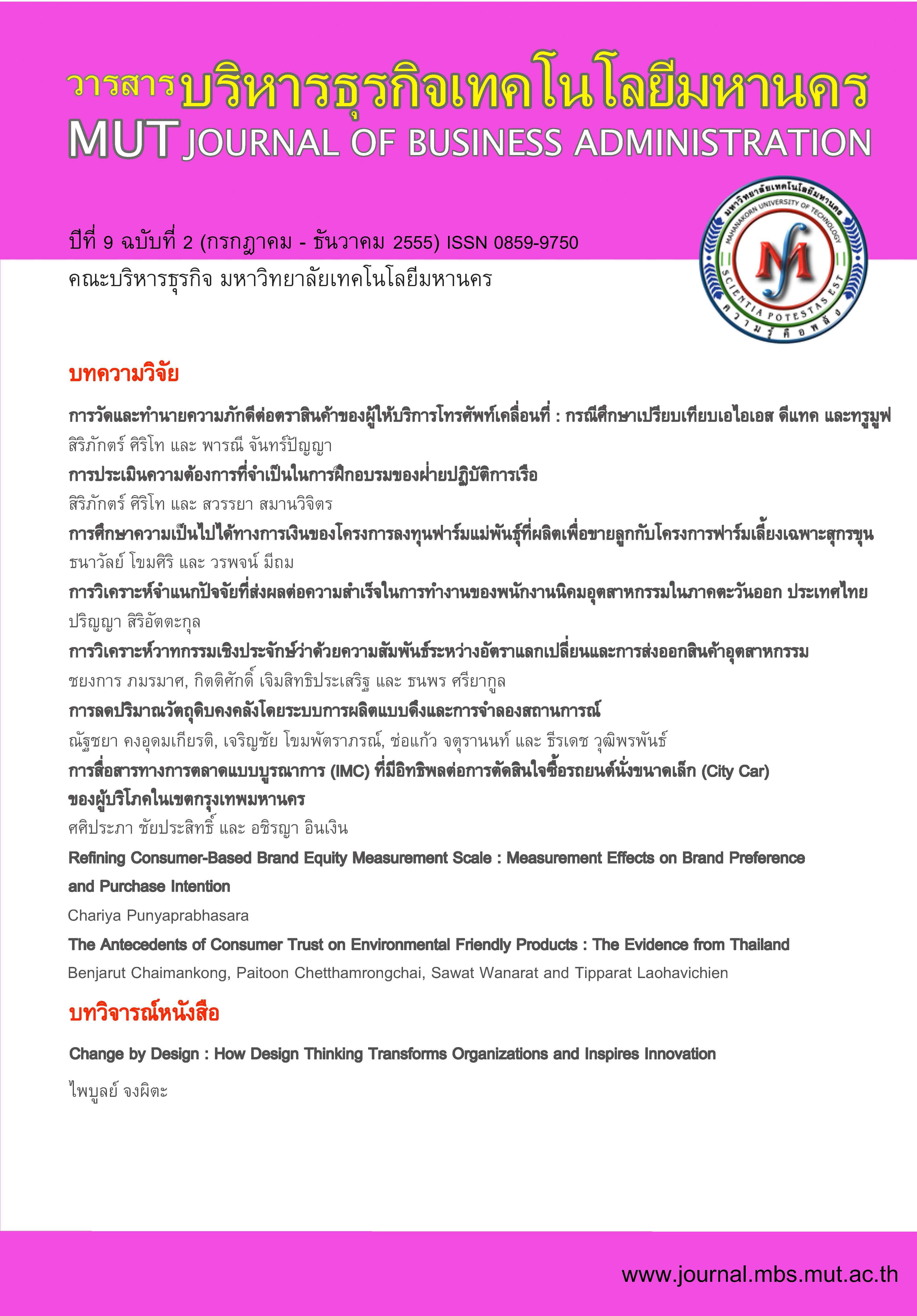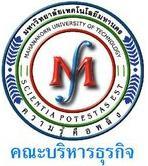การวิเคราะห์จำแนกปัจจัยที่ส่งผลต่อความสำเร็จในการทำงานของพนักงานนิคมอุตสาหกรรมในภาคตะวันออก ประเทศไทย
Keywords:
ความสำเร็จในการทำงาน, พนักงาน, การวิเคราะห์จำแนก, Work Success, Employees, Discriminant AnalysisAbstract
การวิจัยครั้งนี้มีวัตถุประสงค์เพื่อวิเคราะห์ปัจจัยที่สามารถจำแนกความสำเร็จในการทำงาน และความไม่สำเร็จในการทำงานของพนักงานนิคมอุตสาหกรรมในภาคตะวันออก ตัวแปรในการวิจัย ตัวแปรตาม ได้แก่ ความสำเร็จในการทำงาน ตัวแปรอิสระได้แก่ เพศ อายุ ระดับการศึกษา รายได้ นิคมอุตสาหกรรม และประเภทธุรกิจ ตัวอย่างที่ใช้ในการวิจัย คือ พนักงานนิคมอุตสาหกรรมภาคตะวันออก ได้แก่ นิคมอมตะนคร จ.ชลบุรี นิคมอุตสาหกรรมแหลมฉบัง จ.ชลบุรี และนิคมอุตสาหกรรมมาบตาพุด จ.ระยอง จำนวน 450 บริษัท และสุ่มตัวอย่างแบบแบ่งเป็นชั้นด้วยความน่าจะเป็นได้สัดส่วนกับขนาด (Stratified probability proportional to size sampling) เก็บรวบรวมข้อมูลด้วยแบบสอบถาม การวิเคราะห์ข้อมูลใช้ ค่าร้อยละ ค่าเฉลี่ยเลขคณิต ส่วนเบี่ยงเบนมาตรฐาน และการวิเคราะห์จำแนกแบบขั้นตอน
ผลการวิจัย พบว่า ตัวแปรที่สามารถจำแนกกลุ่มได้ดีที่สุด คือ ตัวแปรรายได้ รองลงมา ได้แก่ อายุ ระดับการศึกษา เพศ นิคมอุตสาหกรรมอมตะนคร และนิคมอุตสาหกรรมแหลมฉบัง ตามลำดับ โดยสามารถจำแนกกลุ่มได้ถูกต้องร้อยละ 89.00 โดยกลุ่มพนักงานที่ประสบความสำเร็จในการทำงานสามารถคาดประมาณได้ถูกต้องร้อยละ 83.80 และกลุ่มพนักงานที่ไม่ประสบความสำเร็จในการทำงานสามารถคาดประมาณได้ถูกต้องร้อยละ 92.40 และสามารถอธิบายความแปรปรวนของการจำแนกกลุ่มได้ร้อยละ 52 มีค่าเฉลี่ยคะแนนจำแนกกลุ่ม (Group Centroids) พนักงานที่ประสบความสำเร็จและพนักงานที่ไม่ประสบความสำเร็จ เท่ากับ 1.291 และ -.839 ตามลำดับ
Discriminant Analysis of Factors Affecting Work Success of Employees in Eastern Region Industrial Estates, Thailand
The purpose of this research is to find important factors affecting the work success of group membership among employees in Industrial Estates, East Region in Thailand. The dependent variable was work success. The independent variables were gender, age, educational level, income, area of industrials, and industrial types. The sample consisted of 450 employees in Industrial Estate, East Region selected by stratified probability proportional to size sampling. The questionnaires were designed for collecting data. Statistic methods used in this research were percentage, mean, standard deviation, and discriminant analysis with stepwise method.
The variables which could discriminate the employees who were successful and unsuccessful in work were income, age, educational level, gender, Amata Nakorn Industrial Estate, and Laem Chabang Industrial Estate respectively. Its average accuracy in discriminating was 89.00 %. The group of employees who are successful in work has accuracy in discriminating at 83.80 % and the group of employees who are unsuccessful in work has accuracy in discriminating at 92.40 %. Its capability in explaining discriminant variance was 52 %. The group centroids for the employees who were successful and unsuccessful in work were 1.291, and -.839 respectively.
Downloads
Issue
Section
License
ข้อความ ข้อคิดเห็น ข้อมูล เนื้อหา รูปภาพ แผนภูมิ แผนผัง เป็นต้น ที่ปรากฏและแสดงในบทความต่างๆ ในวารสารบริหารธุรกิจเทคโนโลยีมหานคร ถือเป็นความรับผิดชอบโดยตรงของผู้เขียนบทความนั้นๆ มิใช่เป็นความรับผิดชอบใดๆ ของวารสารบริหารธุรกิจเทคโนโลยีมหานคร และมหาวิทยาลัยเทคโนโลยีมหานคร
บทความที่ตีพิมพ์ในวารสารบริหารธุรกิจเทคโนโลยีมหานคร ถือเป็นลิขสิทธิ์เฉพาะของคณะบริหารธุรกิจ มหาวิทยาลัยเทคโนโลยีมหานคร หากบุคคลหรือหน่วยงานใดต้องการนำทั้งหมดหรือส่วนใดส่วนหนึ่งไปเผยแพร่ต่อหรือเพื่อกระทำการใดๆ จะต้องได้รับการอนุญาตเป็นลายลักษณ์อักษรจากคณะบริหารธุรกิจ มหาวิทยาลัยเทคโนโลยีมหานครก่อนเท่านั้น


